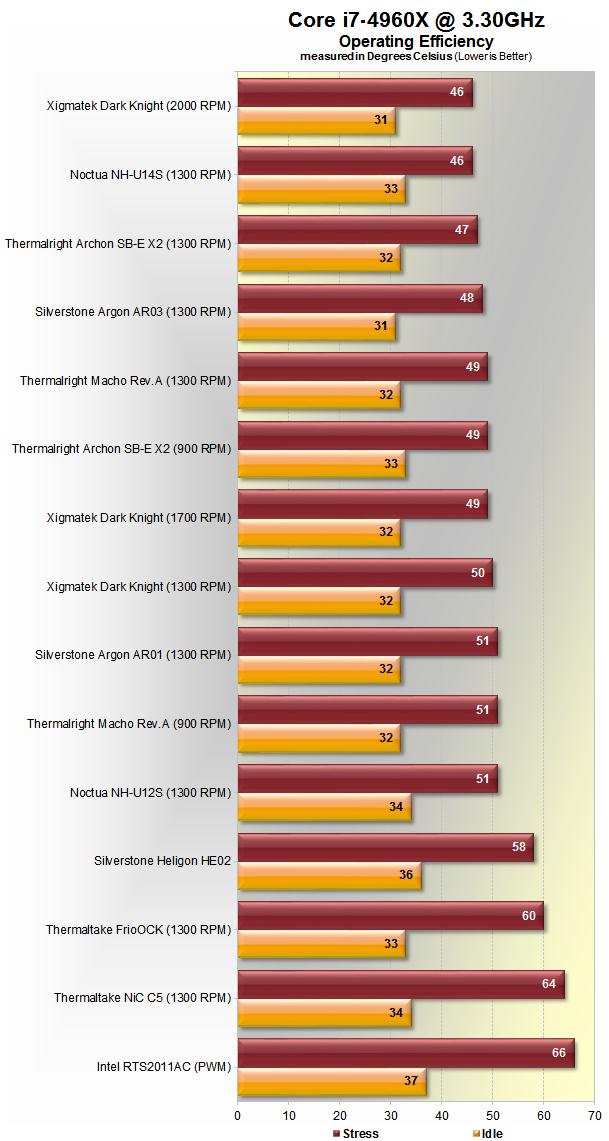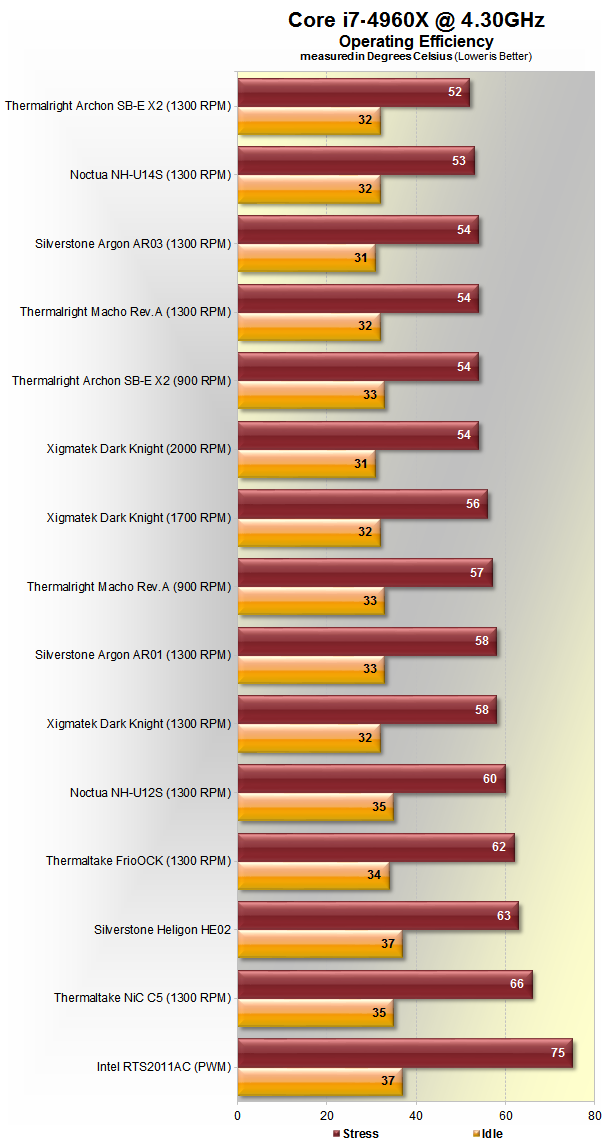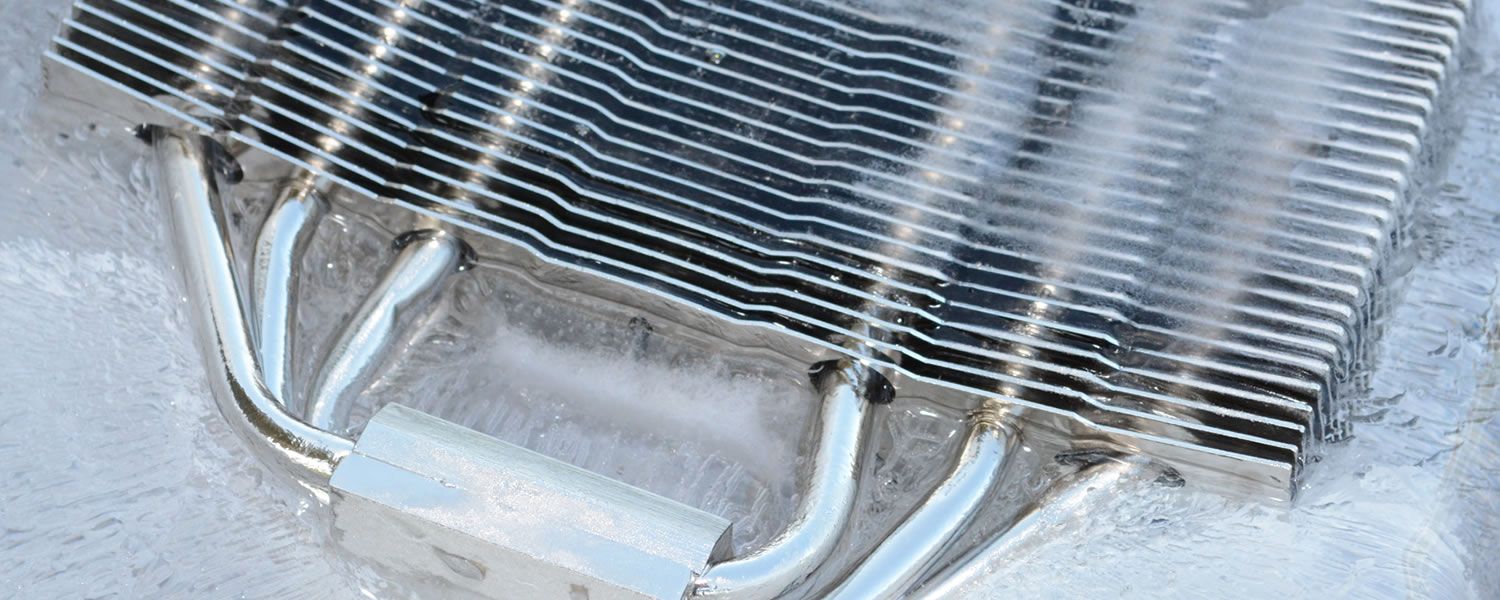Testing Notes, Operating Temperatures
Maintaining an ambient room temperature of 21 degrees Celsius, we ran both the idle and stress tests for 20 minutes to record the lowest and maximum values. Additionally, we remounted and retested each heatsink three times. Prime95 ensured that all four of the i7-4960X's processing cores were pushed to the max during the load tests. We displayed the best results for each instead of averaging everything.

We recorded temps with the same version of Everest Ultimate Edition as well as the same motherboard, processor and BIOS revision. We ran the i7-4960X at its default 3.3GHz in addition to an overclocked 4.3GHz configuration. All tests were conducted using a horizontal motherboard orientation, positioned flat in the Cooler Master HAF XB. Heatsinks with heatpipes are positioned so they span vertically.
Furthermore, we disabled features that would affect the results, including CPU Enhanced Halt (C1E), C3/C6 State Support, CPU Thermal Monitor, EIST and Turbo Boost.

The optional Intel cooler performs quite poorly even when the Core i7-4960X is set to its default frequency of 3.3GHz. Although Prime95 stresses all cores to the max, you'd witness similar loads when performing certain tasks such as encoding and the stock cooler's idle temp wasn't much better at 37C.
The aftermarket coolers did a significantly better job, with the worst performer (Thermaltake's NiC C5) still cutting the stock temps by a few degrees. Further down the line, Thermaltake's FrioOCK shaved another four degrees off the stress test, while Silverstone's passively-cooled Heligon HE02 managed to land between both of Thermaltake's actively-cooled offerings at 63C and 37C.
Temperatures really start to drop from there, with Noctua's NH-U12S besting Intel's stock cooler by 23% with a load temp of only 51C. Of note, we only tested the NH-U12S with its fan set to 1300 RPM as we found it to be very quiet at this speed. Thermalright's Macho Rev.A on the other hand was tested with its fan spinning at 900 RPM and 1300 RPM – the former of which matched the NH-U12S and Argon AR01. However, when pushed to its limits, the Macho Rev.A kept the Ivy Bridge-E chip at a comfy 49C.
The Xigmatek Dark Night's 120mm fan was set to 1300 RPM, 1700 RPM and 2000 RPM – the lowest of which was very tolerable audibly considering its 50C load temp, but that changed quickly as we ramped the rotations up. Running at 1700 RPM only improved things by a single degree despite being much louder, while the highest RPM setting was way too noisy despite knocking another 4C off our stress test.
Thermalright's Archon SB-E X2 kept the i7-4960X at a respectable 49C and 47C when running at 900 and 1300 RPM, while Noctua's NH-U14S was the best all-around performer with similar results to the Dark Knight with its fan running 700 RPM slower.

Overclocking the i7-4960X obviously increases the thermal output and Intel's RTS2011AC cooler hit 75C, up from 66C. The impact on some of our larger aftermarket coolers wasn't nearly as significant, with the NiC C5 and FrioOCK only increasing in temperature by a couple degrees under load. That said, the fanless Heligon HE02 suffered more a 5C spike, while the NH-U12S took an unexpected performance hit with a temp increase of 9C – though to its credit, it still managed to outdo Thermaltake's offerings.
With its fan spinning at 1300 RPM, the Dark Knight saw an 8C increase while the Argon AR01 jumped 7C. The Macho Rev.A saw a 6C increase after overclocking the i7-4960X processor, though its load temp of 57C is impressive considering the fact that its fan was running at 900 RPM. Boosting that to 13000 RPM lowered the temp to only 54C, which wasn't far off from the best overclocking results recorded.
The Dark Knight (1300 RPM) took an 8C hit with a load temp of 58C – on par with the Argon AR01 – and increasing its fan speed to 2000 RPM didn't help much. The Argon AR03, however, was a top performer with a load temperature of just 54C, meeting the Macho Rev.A (1300 RPM), Thermalright Archon SB-E X2 (900 RPM) and Xigmatek Dark Knight (2000 RPM).
The Archon SB-E X2 (900 RPM) also did well as temperatures increased by 5C to 54C. Cranking the fans up to 1300 RPM did the trick as we saw a load temperature of just 52C, only 5C more than the non-overclocked result. In other words, the Archon SB-E X2 beat the Noctua NH-U14S by a single measly degree to win our overclocking test.

It's obviously impossible to beat the fanless Heligon HE02 in a noise test full of actively-cooled heatsinks, but we assume most of you actually want a fan cooling your processor. If noise is a concern but passive cooling is out of the question, your best bet is the Macho Rev.A/Archon SB-E X2 running at 900 RPM, or the Dark Knight/ NH-U12S set to 1300RPM. The Macho Rev.A and NH-U14S at 1300 RPM were also relatively quiet, producing 1dB more noise than the best results we recorded (again, excluding the HE02).
Moving up in volume, the Dark Knight (1700 and 2000 RPM) generated 46dB and 49dB, while the Archon SB-E X2 reached 49dB with its fan moving at 1300 RPM – not bad even if it's 4dB louder than the NH-U14S. On the loudest side of things, the FrioOCK exceeded 51dB when running at 1300 RPM, while the NiC C5 was one of the loudest coolers tested at 54dB. Silverstone's Argon products were also noisy, though all of the above were quieter than Intel's stock assembly.
